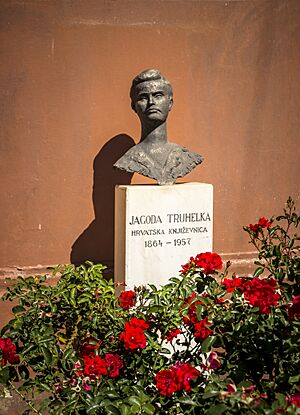Jagoda Truhelka facts for kids
Jagoda Truhelka (born 5 February 1864 – died 17 December 1957) was an important writer and teacher from what is now Croatia. She was born in Slavonia and worked as a teacher and principal in many cities, including Osijek, Zagreb, Gospić, Banja Luka, and Sarajevo. Truhelka wrote novels that often featured strong girl characters and talked about fairness for women. However, she is most famous for her amazing children's literature.
Contents
Early Life and School
Jagoda Truhelka was born on 5 February 1864 in Osijek, a city in a region called Slavonia. At that time, Slavonia was part of the Austrian Empire. She was the oldest of three children. Her father, Antun Vjenceslav Truhelka, was a teacher from the Czech Republic. Her mother, Marija, was from a German-speaking community.
Jagoda went to a high school in Osijek. In 1878, her father passed away. After this, Jagoda moved to Zagreb with her mother and younger brothers, Dragoš and Ćiro Truhelka. Zagreb was then the capital of the Kingdom of Croatia-Slavonia, which was part of the new Austro-Hungarian Empire.
Jagoda continued her studies in Zagreb. She wanted to become a teacher, just like her father. In 1882, she finished her teacher training and received her diploma.
Her Work as a Teacher
Jagoda Truhelka got her first teaching job in 1882, right after she finished school. She taught girls in her hometown of Osijek. After more training, she became the principal of a girls' school in Gospić, where she worked for seven years.
In 1892, she moved to Zagreb for a new job. Zagreb was a lively city with many new ideas in culture and learning. Jagoda spent nine years there and became known as a very good teacher. She also challenged old ideas about how girls should be educated. She was one of only four women to enroll at the University of Zagreb at that time. During these years, Jagoda became interested in ideas about individual freedom and the importance of education and women's rights.
In 1901, Truhelka moved to Banja Luka, which was then part of Bosnia and Herzegovina under Austro-Hungarian rule. She worked as a girls' school principal there for ten years. Later, she taught in Sarajevo, the capital of Bosnia and Herzegovina. In Sarajevo, she worked especially hard to support women's rights.
Writing for Women
Jagoda Truhelka always saw herself as a teacher first. She felt that writing just "came on its own." She wrote many short stories and two longer novels. In 1900, Jagoda Truhelka and Marija Jambrišak started a magazine called Domaće ognjište (The Home Hearth). Many other women writers contributed to it. A famous writer named Antun Gustav Matoš said the magazine was very important because it was "not only a teaching paper but also a women's paper."
In her early stories, Truhelka often wrote about women and their relationships. She published some of these stories in magazines like Vienac and Nada using a pen name, A. M. Sandučić. Many of these were simple love stories set in Zagreb or Vienna. However, they also showed how the female characters grew and changed inside. Truhelka was one of the first Croatian writers to create a female character who was a strong supporter of women's rights and was smarter than others, not just a perfect or evil character.
Truhelka also wrote a psychological novel called Plein air. Parts of it were published in the magazine Nada in 1897. In this novel, she explored ideas about women's rights, marriage, and common social ideas. Another of her novels was Vojača, published in Nada in 1899. This book also had a female main character, a 15th-century Bosnian peasant girl inspired by a real queen named Vojača. Truhelka's Vojača was very sensitive and thoughtful. This novel showed that Truhelka was inspired by the famous writer August Šenoa.
Children's Books
Later in her career, Jagoda Truhelka started focusing on children's literature. Her children's books often included parts of her own life story. Her book Zlatni danci was published in 1918.
Jagoda Truhelka retired in August 1923 and moved back to Zagreb. She continued to write children's books even when she was very old. Two of her other well-known children's books, Bogorodičine trešnje and Crni i bijeli dani, were published in 1929 and 1944. These books, along with Zlatni danci, make her one of the most important children's writers in Croatia, second only to Ivana Brlić-Mažuranić.
In her children's stories, Truhelka described the everyday lives of children. She also tried to teach them about good behavior, faith, and love for their country. Jagoda Truhelka passed away in Zagreb on 17 December 1957, when she was 93 years old. She is still best known for her wonderful children's books.
Images for kids




